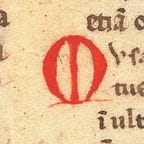Leipzig Cod.Mag.33 — Magical rings
The Leipzig University Library has an extensive collection of XVIII Century magical manuscripts. A complete list of the works can be read on studies-vartejaru.blogspot.com.
Cod.Mag.33 is written in Italian, under the title “Misterio di Pietre sculpite o vero anelli magici naturali de Solomone re d’Ebrei secondo l’originale che si conserva fra i manoscritti rari di Bibliotheca di Vaticano” — A mystery of sculptured stones or natural magical rings of Solomon, King of the Jews, after an original kept with the secret manuscripts in the Vatican Library.
A superficial search has provided no confirmation of the existence of an original at the Vatican library.
This work describes thirty magical rings, each associated with one or more of the seven planets. All rings are illustrated by a schematic drawing labelled with the metal and stone to be used.
Here is the text of one of the rings illustrated at p.11.
Transcription: Anello Mercuriale per convocare et necessitare | spiriti aquatici a parlare con voi et a dar= | vi risposta al quisito.
Farai scolpire in Berillo, se non la trovarai scolpita la figura | di una upupa con un herba dragurta o lingua di serpe avan | ti di se e questa farai ligare in argento o sia mercurio forte | e fortunato in mezzo cielo, o oriente et il medesimo sarà | in Saturno ligato in piombo et in luna ligato in argento | essendo fortunato.
Translation: A ring of Mercury to summon water spirits | and bind them to speak with you and | answer your question.
If you do not find it already carved, you will have this image carved in beryl: | a hoopoe with a dracunculus [? dragurta] or ophioglossum plant in front | of it. You will have [the stone] set in silver, when Mercury is strong | and fortunate in the highest point [medio coeli], or in the East. It will be the same | with Saturn, setting [the stone] in lead, and with the Moon, [setting it] in silver, | when they are in a fortunate position.
The title seems to allude to hydromancy, but the actual use of the ring is not described in the very short text. The different elements of the talismanic image seem also interesting: one could speculate that “ophioglossum” (snake’s tongue) derives from the intertwined snakes in the caduceus. The hoopoe could have been included because of its generic association with divination: Laura Mitchell (Cultural Uses of Magic in Fifteenth-Century England) quotes a spell in MS Ashmole 1435 in which the heart of a hoopoe grants prophetic dreams (Cor ypapa supponatur sub capite dormientis et sompniabit futuram). I am not aware of any relation between dracunculus and Mercury or divination; moreover, the name of the plant is peculiarly distorted, so much so that it could be a reference to some other herb — I do not exclude that “dragurta” is just a synonym of “ophioglossum”.
A similar manuscript from the same collection (Cod.Mag.35) has been fully transcribed and translated by Mihai Vârtejaru on the blog mentioned above.
